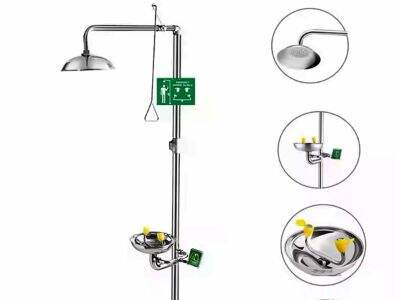Resumo de 'Estações de ducha de lavagem ocular – Como Funcionam e Por Que São Importantes' – Locais de trabalho são lugares perigosos. É muito importante que todos entendam o princípio das estações de ducha de lavagem ocular e o que as torna úteis, para começar. Nossas partes do corpo são muito sensíveis, e nossos olhos se machucam com facilidade o tempo todo. Em lugares como fábricas ou laboratórios, onde uma grande quantidade de vários químicos e outras substâncias perigosas são misturados, ter Série de Lavagens Oculares estações de ducha à mão e saber como usá-las é uma grande precaução. Tais estações são destinadas a lavar produtos químicos nocivos ou outras coisas perigosas dos nossos olhos para prevenir lesões graves.
Uso de Emergência das Estações de Ducha de Lavagem Ocular.
Se algo prejudicial entrar em contato com os olhos, é muito importante saber como usar corretamente uma estação de ducha ocular. É necessário puxar a alavanca para iniciar o fornecimento de água, antes de tudo. Esta etapa será a mais útil. Em seguida, você precisa colocar os olhos e a água deve lavar a substância nociva. Ao mesmo tempo, é necessário piscar suavemente, para não espalhar os químicos. Parágrafo 4 - Prevenção de lesões oculares. As estações de ducha ocular também desempenham um papel decisivo na prevenção de lesões graves nos olhos em um local de trabalho superlotado. Lavar imediatamente nossos olhos de substâncias nocivas em caso de algo dar errado, é isso que a torna uma boa medida. Em caso de ação rápida, é possível minimizar os danos que podem ser causados por químicos ou outras substâncias perigosas. Quando algo acontece, essa ação rápida pode salvar nossos olhos. Por isso chuveiro e lavador de olhos estações são uma parte integrante da segurança no local de trabalho.
As estações de ducha ocular mantêm os trabalhadores seguros.
É essencial que haja estações de ducha e lavagem ocular disponíveis no local de trabalho para garantir que todos os funcionários estejam seguros. Em casos de acidentes envolvendo substâncias perigosas, o acesso rápido a uma estação de lavagem ocular única estação pode ser crucial para evitar lesões graves. Os empregadores são responsáveis pelas condições de trabalho seguras dos seus funcionários. As estações de ducha e lavagem ocular são um aspecto extremamente importante para manter a segurança e saúde de todos os trabalhadores.
A importância das estações de ducha e lavagem ocular em ambientes perigosos.
As estações de ducha e lavagem ocular são essenciais em lugares perigosos. Em uma emergência, quando cada segundo conta, o acesso rápido a uma estação pode ser a diferença entre um pequeno incidente e algo mais sério. Essas estações proporcionam alívio imediato para nossos olhos e podem definitivamente fazer com que os trabalhadores se sintam seguros ao trabalhar em ambientes perigosos.
Saber que a ajuda está a uma rápida chamada de distância pode proporcionar tranquilidade aos trabalhadores.
As estações de ducha apenas para lavagem ocular são extremamente valiosas para atender aos requisitos de segurança em trabalhos perigosos com resposta a emergências. Quando usadas corretamente, elas podem ajudar a prevenir lesões oculares significativas e garantir que o local de trabalho seja seguro para todos. Os trabalhadores poderão confiar que as estações com duchas de lavagem ocular MERNUS instaladas terão as ferramentas essenciais para mantê-los seguros caso ocorra um acidente. Certifique-se apenas de seguir as diretrizes locais, pois a segurança sempre vem em primeiro lugar, e estar preparado pode fazer a diferença entre manter todos seguros e saudáveis!
Table of Contents
- Uso de Emergência das Estações de Ducha de Lavagem Ocular.
- As estações de ducha ocular mantêm os trabalhadores seguros.
- A importância das estações de ducha e lavagem ocular em ambientes perigosos.
- Saber que a ajuda está a uma rápida chamada de distância pode proporcionar tranquilidade aos trabalhadores.

 EN
EN
 AR
AR
 BG
BG
 HR
HR
 CS
CS
 DA
DA
 NL
NL
 FI
FI
 FR
FR
 DE
DE
 EL
EL
 IT
IT
 JA
JA
 KO
KO
 NO
NO
 PL
PL
 PT
PT
 RO
RO
 RU
RU
 ES
ES
 SV
SV
 TL
TL
 ID
ID
 LT
LT
 SR
SR
 SK
SK
 UK
UK
 HU
HU
 TH
TH
 TR
TR
 AF
AF
 MS
MS
 GA
GA
 KA
KA
 BN
BN
 LA
LA
 MN
MN
 KK
KK
 UZ
UZ
